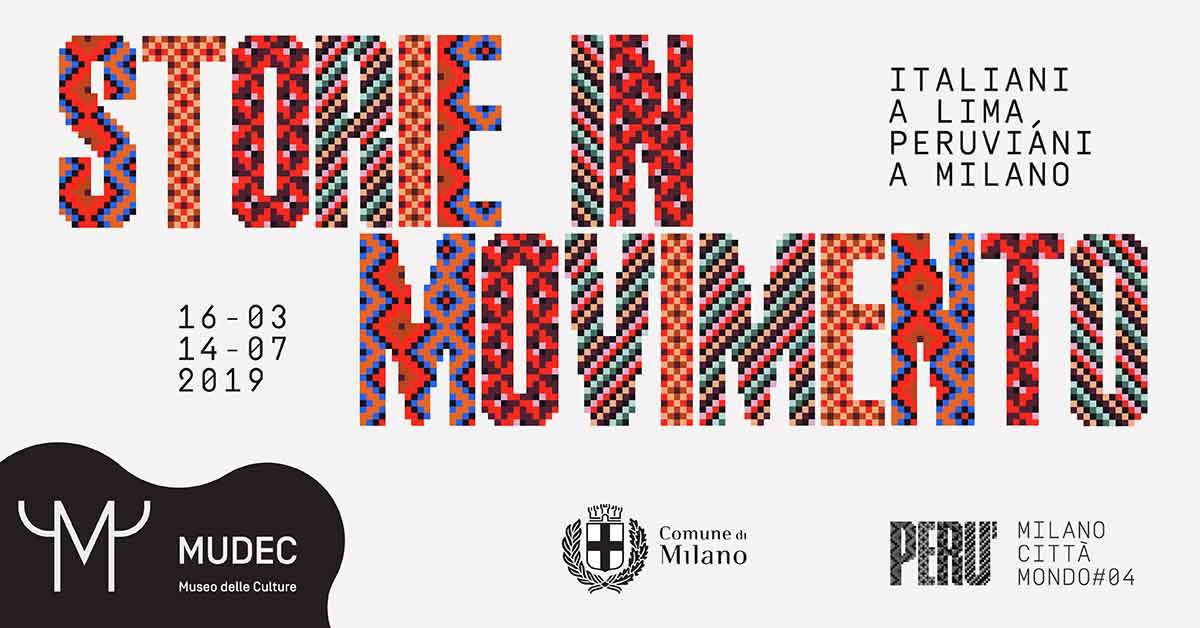As part of the 2019 edition of the Milan City World project, MUDEC opens the exhibition Stories on the Move. Milanese in Peru, Peruvians in Milan from March 16 to July 14. The exhibition, from the perspective of a history made by people, starts from individual testimonies and attempts to reconstruct, against the light, some social and economic dynamics. People’s voices, their personal or imposed motivations, their aspirations and dreams become the stories of all those who left or, conversely, welcomed.
The exhibition begins with a brief introduction summarizing the centuries-old relationship that unites Italy and Peru and in particular Milan and Lima. In fact, Milan’s connection with Peru has very ancient origins dating back at least to the travels of the Milanese Girolamo Benzoni (Milan, 1519 - c. 1570), a celebrated explorer and writer. But it was especially in the second half of the nineteenth century that ties intensified thanks to the increasingly prominent role that the Italian commercial petty bourgeoisie, together with a close circle of intellectuals who were often Risorgimento exiles, began to play in Peruvian society after the country’s independence (1821). Peru, freed from the restrictions on free movement of people dictated by the Spanish regime, welcomed from the last quarter of the 19th century some 10,000 Italians, often of Ligurian descent. Among the most famous “emigrants” of this period is the Milanese Antonio Raimondi (Milan, 1824 - San Pedro de Lloc, 1890), a distinguished scientist whose bequest is considered one of the founders of the ethnographic collection of the City of Milan, now preserved at MUDEC. The stabilization of Italian residents continued through ups and downs (for example, during the war with Chile), always with a primarily commercial and industrial focus. It culminates with the opening in Lima in 1889 of the Italian Bank, which soon became the most innovative and important in the country.
During the 20th century, the Italian presence in Peru declines and is concentrated in Lima. The situation in Europe became complicated as a result of world conflicts, and from the 1970s Peru entered a phase of political instability that did not encourage immigration but, on the contrary, fostered the diaspora of Peruvians around the world, who leave for Italy especially from the 1990s onwards with economic but also political motivations. The flow is only minimally made up of Italians returning to the motherland.
The path of the exhibition then proceeds by focusing on the voices and experiences of two prominent figures in the Italian and Peruvian cultural and artistic scene of the 20th century: Antonello Gerbi and Jorge Eduardo Eielson. Antonello Gerbi (1904 - 1976), an eminent historian and economist, was forced into a long exile in Peru at the time of racial laws and World War II. The scholar conducted important research in the Latin American country, becoming passionate about the local culture and becoming an expert connoisseur of it, recognized in Peru and internationally. Jorge Eduardo Eielson (Lima, April 13, 1924 - Milan, March 8, 2006), a multifaceted Peruvian artist, came to Europe in 1948, the year of Gerbi’s return to Milan, and then chose Italy as his adopted country and has resided in Milan since the 1970s. His art is grounded in and imbued with ties to the natural environments and pre-Hispanic cultures of Peru.
Through the intellectual and artistic experiences of Gerbi and Eielson, respectively, the links between Milan and Peru in the 20th century are featured in a fruitful dialogue with objects from Mudec’s ethnographic collection. The last section of the exhibition will present to the public, in the form of a video-fresco the current and contemporary “moving stories” of Peruvians in Milan, stories, life experiences that address some recurring and heartfelt themes of what is now the fourth largest community of new citizens living in Milan: displacement, family ties, religiosity, continuity and rupture with the traditional systems of expression of the culture of origin (lo andino) establishing links of meaning and through material culture with the other sections of the exhibition.
The interviews are a partial but necessary restitution of the extensive fieldwork conducted during 2018 by a team of anthropologists coordinated by Prof. Sofia Venturoli of theUniversity of Turin and Dr. Carolina Orsini conservator of Mudec, on some Peruvian families living in Milan. The exhibition thus invites visitors to discover, through documents, photographs, works of art, images, objects and direct testimonies, the close ties that today as in the past characterize Peruvian culture, which is strongly linked to the country’s pre-Hispanic history and culture.
The exhibition, the result of a collaboration between Mudec and the Department of Linguistic Mediation Sciences and Intercultural Studies of the University of Milan, has seen the collaboration of numerous private archives including that of the Gerbi Family, preserved at the Intesa Sanpaolo historical archive and the archive dedicated to the life and works of Jorge Eduardo Eielson, preserved at the Centro Studi Jorge Eielson in Florence and the Il Chiostro art gallery in Saronno.
Accompanying the exhibition is a rich schedule of activities, organized by theOffice of Networks and Cultural Cooperation, which includes lectures, meetings, visits and workshops. The exhibition is curated by Giorgia Barzetti, Maria Matilde Benzoni and Carolina Orsini. For all information you can visit the official MUDEC website.
 |
| Milanese in Peru and Peruvians in Milan: at MuDEC the exhibition as part of the Milan City World project |
Warning: the translation into English of the original Italian article was created using automatic tools. We undertake to review all articles, but we do not guarantee the total absence of inaccuracies in the translation due to the program. You can find the original by clicking on the ITA button. If you find any mistake,please contact us.